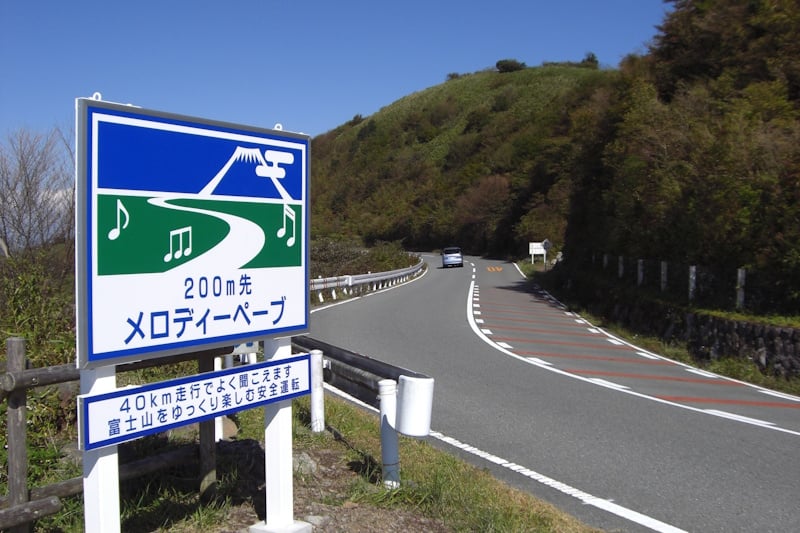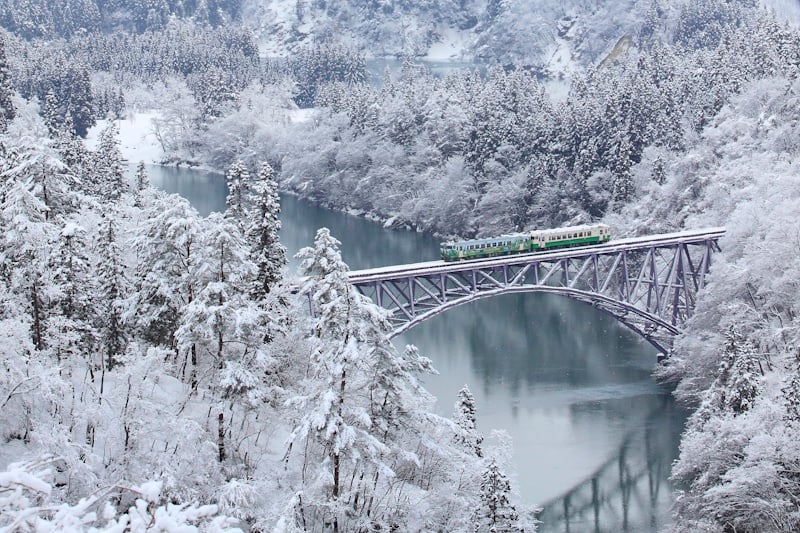My wife and I recently went on a brief day trip to Yamanashi Prefecture, which always soothes her soul. On the way there, she asked, “Wanna check out the Melody Road?”
I had never heard of Japan’s musical roads (メロディーロード; “melody road”) before this. Digging in, I was surprised to find there were several dozen of these locations in Japan alone – and many more all over the road. Here’s the background on this clever invention, along with some of the more famous musical roads connected to Japanese pop culture.
The invention of the musical road
 Picture: 交通素材家 はそぴ / PIXTA(ピクスタ)
Picture: 交通素材家 はそぴ / PIXTA(ピクスタ)
Musical roads are variations on the rumble strip, which warns sleepy drivers when they’re veering off the road. Some enterprising folks discovered that, if you put such grooves in the road apart at specified intervals, they’ll produce musical notes.
Two artists in Denmark, Steen Krarup Jensen and Jakob Freud-Magnus, created the first musical road in 1995. They took off in 2007 when Japanese engineer Shinoda Shizuo accidentally created musical notes while using a bulldozer. His company, Shinoda Manufacturing, teamed up with the Hokkaido Research Organization to perfect the technology.
Since then, musical roads have appeared all around the world. In many cases, they’re used to draw tourists. Other countries, however, install them as a safety measure. Some maintain that the songs keep drivers alert and awake. Since the song is only played correctly when a driver is moving at the correct speed, they can also encourage people to mind speed limits.
Enjoying anime roads and more in Japan
Since then, numerous musical roads have popped up all across Japan. Wikipedia JP currently lists 37 in existence around the nation. A few of these will no doubt be of interest to those whose primary draw to Japan is pop culture – specifically, anime and manga. Below, I’ve listed some of the highlights in each region of the country.
Obviously, if you want to enjoy these as a traveler to Japan, you’ll need to rent a car. Before you leave for your trip, make sure you get an International Driver’s Permit (IDP). These licenses are recognized by any country that participates in the 1949 Geneva Convention. They can only be issued by your country, so it’s best to get one before you leave for your trip.
For United States residents with a valid US state driver’s license, you can get one at any AAA branch for $20. You’ll need to fill out the application and bring two passport photos, too. If you’re already abroad and are staying for a while (e.g., you’re staying in Japan for a full 90 days or want to get a temporary license before getting an official Japanese driver’s license), you can request one by mail.
The Cruel Angel’s Thesis Road – Hakone
The Cruel Angel’s Thesis road.
The most accessible for most vacationers to Japan will be the road near Lake Ashi in Hakone, a short 90-minute drive from Tokyo. It’s along the Ashinoko Skyline, which is a sight in its own right. The Skyline gives stunning views of Mt. Fuji in the west and Lake Ashi to the east.
The road is also notable for playing Cruel Angel’s Thesis, the theme song from the popular anime Neon Genesis Evangelion, on the descending road. The road opened on April 21st, 2015. The ascending road plays Fujinoyama, a Japanese folk song dating back to 1910.
The full version of Fujinoyama, if you want to add another song to your karaoke repertoire.
The Ashinoko Skyline is a toll road, so make sure when you rent a car that you also rent an ETC card, which is the card recognized for automated tolling on Japan’s highway systems. It costs 1,000 yen for regular-sized vehicles.
Yamanashi Prefecture – Lake Kawaguchi’s Fuji Subaru Line
Our drive over the Fuji Subaru Line.
The Fuji Subaru Line leads to one of the most popular of the four stops at Mt. Fuji’s 5th Station, where hikers depart for their climbs during hiking season. (And only during hiking season…right? Right??) At 2,300 meters above sea level, it’s also a good spot to soak up some views even if you don’t intend to climb the mountain.
Along the way, you’ll hit a stretch of road that plays Fujinoyama. It plays the first part of the song on the way to Mt. Fuji and the latter half of the song on the way back.
Gunma Prefecture – National Highway 353
Gunma Prefecture has a total of 10 musical roads – 27% of all such roads in Japan. Perhaps the one of greatest interest to Japanese pop culture fans is this one on National Highway 353, which plays Itsumo Nademo, the theme song from Hayao Miyazaki’s popular animated film Spirited Away. This road leads to Shima Onsen, which served as the basis for the spirit world onsen in the film.
(If you want to visit a slightly less popular bathing spot, check out our list of hidden onsen across Japan.)
Gunma Prefecture – Gunma Melody Line
A collection of all 10 musical roads in Gunma, including When You Wish Upon a Star.
Let’s not limit ourselves to Japanese animation, folks! Disney is incredibly popular in Japan, which is reflected in Prefectural Highway 36’s Melody Line. The road is en route to the Gunma Astronomical Observatory, where you can get some killer views of the night sky in Japan. So, appropriately enough, this road plays When You Wish Upon a Star from Pinocchio.
Tottori Prefecture Highway 47 Yonago Sakai Minato
If you travel to Shimane Prefecture to visit the spectacular Izumo Taisha Shrine, you’ll likely need a car once you get there. But that also means you can pop over to Tottori Prefecture and ride Highway 47, which will play out the theme song to the popular yōkai anime GeGeGe no Kitarō.
Fukushima Prefecture – Okuaizu Symphony Road
 JR Tadami Line. (Picture: くまちゃん / PIXTA(ピクスタ))
JR Tadami Line. (Picture: くまちゃん / PIXTA(ピクスタ))
You should travel this road anyhow because it’s beautiful, as it travels along the breathtaking JR Tadami Line. When you do, you’ll also be treated to a little musical ditty that may be familiar to US travelers: Country Road by John Denver. If you time it right, you can listen to the song as you pass in tandem with the train on the Tadami Line.
Hiroshima Prefecture – Fruits Road
Drivers on the Yasuda-Kamo line in the town of Sera who maintain a 60km/h speed will be treated to another Studio Ghibli treat: Sampo from My Neighbor Totoro. It’s quite a trip, however: If you’re in Hiroshima to see sights such as the Peace Memorial Park, it’ll take you over a 90-minute drive to get out there.
Sources
Musical Road. Wikipedia (EN + JP versions)
『残酷な天使のテーゼ』が聞こえてくる“エヴァンゲリオン メロディペーブ”が4月21日より開通. Famitsu
車で走ると道路から演歌やアニメ曲 その仕組みは「レコード盤」. Asahi Shimbun
【2025年最新】全国のメロディーロード – 全37ヵ所. Gaisha Baton




